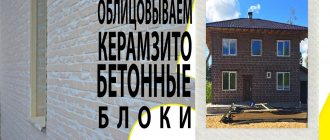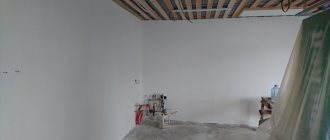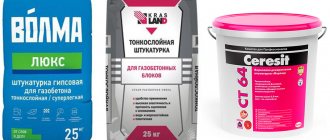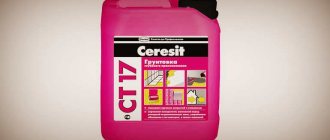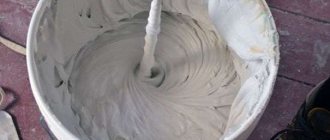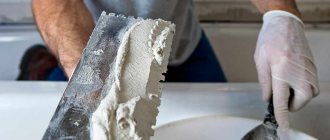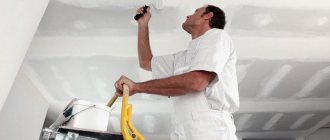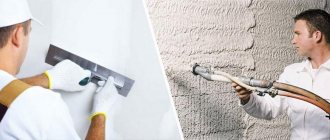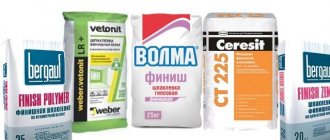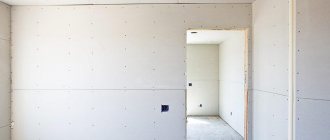The construction of houses and other structures from expanded clay concrete blocks has long been firmly established in our daily lives. And indeed, building a building from such material is much faster than, say, from ordinary brick, and more economical. There are two main disadvantages of houses made of this material: unpresentable appearance and ventilation of the porous structure of the block. In order to improve the walls and get rid of blowing, it is necessary to plaster the surface of expanded clay concrete walls on both sides. Even if you want to clad the house with siding, there should be minimal grouting of the pores under the finishing of the facade.
Many developers believe that finishing expanded clay concrete walls is not necessary. Indeed, a building constructed from such blocks does not require mandatory finishing in some situations - the material is quite resistant to high humidity, temperature changes, and ultraviolet radiation, and can last for quite a long time - several decades. But this is correct if we are talking about some kind of garage, barn or other utility room, where functionality comes first, and parameters such as beauty, aesthetics and the special durability of the building are not very important. But if you want your house to please you and your children and grandchildren, and to last for at least a century, then you should think about it.
In what cases does it make sense to finish a house from expanded clay concrete blocks:
- if additional insulation of the room is necessary - external plaster with or without a combination of insulation and a vapor-permeable membrane;
- during the construction of a residential building - exterior and interior decoration;
- during the construction of basement floors, semi-basements, and other underground structures - a special waterproofing coating on the outside of the walls.
Why do you need to plaster the walls of a house made of expanded clay concrete?
As mentioned above, plastering the walls of a residential building built from expanded clay concrete is recommended in most cases. For what? Let's think logically. The building block discussed in this article is essentially expanded clay and a cement binder that allows it to maintain its given shape. At the same time, a huge mass of pores is formed in it, through which air circulates quite freely. As a result, unplastered walls made of such material will simply be blown out, which will make the home cold and uncomfortable.
Plastering only from the inside will not bring much reduction in the level of heat loss, since cold air will also freely penetrate the wall from the street, right down to the inner layers, take away heat, and also escape freely. This is despite the fact that there should be no drafts in this case.
If a decision is made to finish an expanded clay concrete house, it must be plastered, both inside and outside. High-quality external and internal plaster will significantly increase the service life of the walls, and will allow you to fully use the heat-insulating properties of the material - you will get something like a “thermos” that perfectly retains heat.
Conclusion
Expanded clay concrete block is plastered to level the surface of the masonry, improve the performance properties of buildings and subsequent decoration. Plaster mixtures have application nuances that require consideration.
Many developers believe that finishing expanded clay concrete walls is not necessary. Indeed, a building constructed from such blocks does not require mandatory finishing in some situations - the material is quite resistant to high humidity, temperature changes, and ultraviolet radiation, and can last for quite a long time - several decades. But this is correct if we are talking about some kind of garage, barn or other utility room, where functionality comes first, and parameters such as beauty, aesthetics and the special durability of the building are not very important. But if you want your house to please you and your children and grandchildren, and to last for at least a century, then you should think about it.
In what cases does it make sense to finish a house from expanded clay concrete blocks:
- if additional insulation of the room is necessary - external plaster with or without a combination of insulation and a vapor-permeable membrane;
- during the construction of a residential building - exterior and interior decoration;
- during the construction of basement floors, semi-basements, and other underground structures - a special waterproofing coating on the outside of the walls.
Types of plaster for finishing the walls of a house made of expanded clay concrete blocks
Depending on the purpose of the room and the functions of the finishing layer, the surface of a house made of expanded clay concrete sides can be covered with:
- A solution based on cement and sand. This is the simplest, cheapest (if you take into account only the cost of raw materials) and affordable option. In the recent past, when other types of ready-made dry compositions were not yet widespread on the construction market, this finishing was the only possible one. Note that this option is not the best and has a serious drawback, which will be discussed below.
- Special mixtures based on cement, various additives, plasticizers and fillers. This plaster is more convenient to use, more durable, and has a number of positive properties.
- Water-repellent compounds - to protect the walls of houses that have to work in difficult climatic conditions, or for buildings located below zero ground level.
- Gypsum-based mixtures are used only for interior plaster of residential premises with normal humidity. This finish has its own specifics; a separate section will be devoted to it.
As you can see, the choice is quite large. The basic requirements for any type of plaster are the ability to apply it in a thick layer and good vapor permeability.
Types of plaster
Surfaces made of expanded clay concrete blocks are plastered with cement-sand and gypsum mixtures. Plaster reduces the thermal conductivity of walls and provides the correct gradient of vapor permeability. Ease of use and adhesion strength to expanded clay concrete walls are higher with sand-cement plaster. However, the surface of masonry stones unevenly absorbs moisture from the mortar, which can lead to fragmented shrinkage and disruption of the aesthetics of the surface. Another danger is possible weak adhesion between the plaster and the wall surface.
Cement-sand
The plaster goes well with wall blocks due to the identical compositions. It is ideal for tightly closing pores, cracks and smoothing seams, which is important with constant changes in humidity and air temperature. This plaster can be easily painted to form the desired exterior façade or interior walls. Plastering creates additional pressure on the foundation, which should be taken into account.
Advantages
Cement-sand plastering is the simplest and most aesthetic finishing method. The composition of the mixture has high adhesion to the base of expanded clay blocks, which creates a durable coating. It is better to cover masonry in rooms with high internal humidity with this mixture. This coating saves the project budget.
Plaster
This material has a lower density and increased thermal insulation properties compared to a cement-sand mixture. This type of plaster does not adhere well to the base unless ingredients with concrete contact properties (or ready-made dry mixtures) are used.
Advantages
In terms of performance characteristics, plastering with a gypsum-based mixture is similar to a sand-cement composition. However, the material itself per unit area (with the same layer thickness) is lighter than the cement-sand mixture and somewhat warmer. The exterior of the finished surface can be perfectly smooth.
The main nuances when finishing expanded clay concrete walls
Let's digress a little from the topic and talk about the material itself. The block, as we have already discussed above, consists of concrete and expanded clay. It has good vapor permeability, low thermal conductivity, and is relatively lightweight. However, its surface is far from perfectly smooth - there may be various pores, cavities, and protrusions. At the same time, it perfectly absorbs water from the external environment (for example, during rain or groundwater). And its geometric dimensions, as a rule, are characterized by significant deviations - up to several centimeters. It goes without saying that a wall built using these blocks will not have a clean surface or evenness. Hence the requirement for the thickness of the layer that the plaster can work with.
Of course, you can use thin-layer mixtures, but, as practice shows, this will be a more labor-intensive, time-consuming and expensive process. In this case, you will need to apply several layers, and each one must gain a certain strength - and this takes time. In addition, you need to provide the embedded elements necessary to connect them, or use a special plaster mesh. Alternatively, the first layer can be made in the form of separate “cakes” applied with a trowel or plaster trowel, which is then well primed after hardening, and after this the surface is finally leveled. As you can see, the process is quite tedious.
Application technology
The expanded clay concrete surface is pre-cleaned, the masonry seams are processed, and then it is primed. Next, the surfaces are reinforced with mesh. The prepared solution is applied and, after drying, rubbed until ready for decoration.
Preparing the wall surface
Before plastering, any dirt, dust, oil or grease stains on the wall blocks are removed. The mortar that protrudes above the surface of the masonry gets knocked down.
Seam processing
Cracks and seams are sealed with sand-cement mortar. When they are narrow and deep, they are embroidered to allow the material to penetrate. All recesses are aligned to the plane of the wall to ensure more uniform shrinkage of the plaster. The surface must be dry before the next operation.
Primer
Before using the gypsum composition, expanded clay concrete blocks are treated with agents that improve mutual adhesion. Liquid quartz primers, polymer dispersions, as well as “concrete contact” type compositions intended for expanded clay blocks can be used. At the same time, you can use ready-made plaster mixtures that already contain additives for similar purposes. Then the blocks will not require preliminary priming.
Gypsum plaster for expanded clay concrete houses
Let us repeat that any gypsum mixture is used exclusively for interior decoration. And its application has a number of features, which we will now discuss. First of all, the blocks are based on cement, and the plaster discussed in this paragraph is gypsum. These two materials have different pH levels, in other words, an indicator of acidity. Expanded clay concrete gives an alkaline reaction (this is what explains skin irritation when working with cement mixtures), and gypsum shows an acidic reaction. From the school chemistry course we remember what happens when these two media are mixed - neutralization.
Let's get back to practice. Gypsum plaster is applied to a wall made of expanded clay concrete blocks. The contact surface enters into a neutralization reaction - let us clarify that this does not happen quickly, but still, it is necessary. As a result, the interface between the media loses its strength, which can ultimately lead to such an unpleasant phenomenon as peeling of the plaster. What to do in this case?
In fact, the problem can be solved quite easily; you simply need to prime the surface of the walls well, and the primer should be specifically designed for concrete foundations. It is applied in two layers - the first is diluted with water to penetrate deeper into the material and create a strengthened layer. After the first one has dried (this is a very important point), the second one is applied, undiluted, which creates the necessary film at the interface between the media. And only then feel free to use gypsum plaster, there will be no problems.
Priming the surface of the walls should not be neglected when using any type of finish. As practice shows, the adhesion strength of the plaster to the base increases significantly.
In conclusion, we can say that for finishing expanded clay concrete walls, ready-made dry mixtures are suitable, which are used for houses made of gas silicate or foam concrete, which also have high vapor permeability. We can recommend materials such as Baumit HandPutz sand-lime plaster for manual finishing, which has excellent characteristics, or particularly durable acrylic plaster, such as Bolix and Bolix Complex. It is also worth noting the very high-quality and durable compositions based on silicate and silicone, produced by domestic and foreign manufacturers.
Description of expanded clay concrete blocks
Expanded clay concrete blocks have many advantages compared to other materials:
- the main aspect is the environmental friendliness of expanded clay concrete blocks;
- low thermal conductivity;
- frost resistance;
- moisture resistance;
- high vapor permeability;
- not susceptible to rotting and rust.
In terms of finishing, this material is also very convenient; the surface of expanded clay concrete blocks is smooth and does not require a large amount of leveling of the masonry. It is also a very durable material and therefore can withstand any decorative finishing. Some craftsmen glue tiles or facing stones directly onto the surface of the blocks, but we recommend first plastering the walls with a small layer (up to 1.5 cm). It will not only help the cladding adhere better, but also, in the case of wallpapering or painting, it will hide the seams of the expanded clay concrete masonry.
Ready-made interior with wallpaper on the walls
Types of plaster
Expanded clay concrete walls can be plastered with both cement-based and gypsum-based compounds.
Professional spray plastering of expanded clay concrete wall
Advantages of cement-sand plaster:
- the composition includes cement - a material that is present in the blocks themselves, which contributes to good adhesion of the plaster to the wall surface;
- enhances the strength of masonry;
- suitable for interior and exterior decoration;
- possibility of cooking with your own hands.
Advantages of gypsum plaster:
- is not inferior in strength to cement-sand plaster;
- creates a smoother surface;
- has better thermal insulation properties compared to cement-sand mortar.
Plastering with cement-sand mortar
It is better to plaster rooms with high humidity: kitchens, bathrooms, etc., as well as cladding the outside of the building with cement-sand mortar.
Cement-sand mortar
An expanded clay wall does not require a thick layer of plaster; it is necessary to level the surface, hide the seams of the masonry, and cement-sand plaster on the outside of the building improves the waterproof qualities of the wall, protects the masonry from temperature changes, and creates a pleasant decorative appearance of the building facade.
It is possible to plaster expanded clay with a cement-sand composition without the use of reinforcing fine mesh, since usually the layer of plaster is no more than 1 centimeter. If you have the means, it is better to use it to increase the strength of the coating; it is very easily attached to expanded clay using dowel nails with a wide head, but this is not necessary.
It is enough to plaster the expanded clay in 2 thin layers, followed by grouting the dried mortar.
Do not forget to clean the surface from dust, debris and protruding masonry mortar before starting work. The solution must be chipped with a chisel.
Unlike gas silicate blocks and foam blocks, expanded clay concrete blocks do not absorb much moisture from the solution, so they can be plastered immediately without first passing a primer over the surface. It is enough to moisten the wall with water while applying the cement-sand mortar.
Gypsum based plaster
Gypsum plaster has a number of its advantages, which is why builders use it as often as cement-sand mortar.
Gypsum plaster reduces the thermal conductivity of the building, it is much more flexible and easier to work with. The coating made from gypsum plaster is smoother; decorative finishing can be applied to it immediately; it is perfect for wallpaper and painting. Thanks to modern technologies, compounds are added to gypsum plaster that increase its strength, so heavy facing materials can be glued to gypsum in the same way as to cement-sand mortar. The main thing here is to use a gypsum mixture designed specifically for heavy materials.
When plastering expanded clay concrete blocks with a gypsum-based composition, it is imperative to pre-treat the wall surface with agents that improve adhesion between it and the blocks. Such compositions are called “concrete contact”.
For wet rooms, use special gypsum mixtures, marked accordingly on the packaging.
Sheathing with plasterboard sheets
There is another way to finish an expanded clay concrete wall from the inside of a building - covering it with plasterboard sheets.
Wall covering with plasterboard sheets
Expanded clay concrete blocks hold anchors, screws, etc. very well, so metal profiles are attached directly to the wall. In the space between the wall and the plasterboard, you can lay an additional layer of insulation - an additional advantage of using plasterboard sheets.
Installation of plasterboard sheets is the same as for other types of walls, very simple and quick. Afterwards all that remains is to putty the joints of the plasterboard sheets and cover the entire surface with a thin layer of finishing putty.
Installation of plasterboard sheets is the easiest type of room finishing, but do not forget that this method conceals space.
The three methods described above are the most suitable types of finishing expanded clay concrete blocks. Which one will be better for you, decide for yourself. You can also learn how to properly prepare plaster solutions and apply them to the surface on our website. Have a nice renovation!
